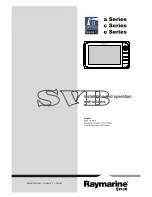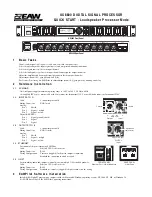
At 100MHz, the pulse period is 1/100 × 10
-6
s = 10
-8
s = 10ns; this is the
unit interval (UI). For example, a value-in fact, any parameter that is
specified in time units-of 37ns is equivalent to 37ns/10ns=3.7UI (time
values are expressed as multiples of the unit interval).
This makes it easy to analyze measurements at different frequencies:
Ifthe measured phase margin is 8ns at 100MHz (1UI=10ns), and 4ns at
200MHz (1UI=5ns): The phase margin is 0.8UI in both cases, and it is
immediately obvious that it does not depend on the system frequency.
The same is true for the delay resolution parameter in the DUT Output
Timing/Jitter and Eye Opening measurements: If you specify the delay
resolution as 0.01UI, the measurement software will always measure
150 points across the bathtub, no matter what system frequency you
choose (only if edge optimization is switched off, of course). However,
if you specify the resolution in time, the number of measured points will
change inversely proportional to the system frequency (doubling the
frequency results in half the number of measured points).
Syntax Requirements
All time-related entries understand both time and unit interval
notation, regardless of the UI/time selection made in the
View
tab of the
Properties
dialog box. You can enter
17s
,
5ns
or
0.01UI
at any time. On
run, the Serial BERT will automatically convert all entries to time
values, using the current unit interval. So, the UI is handy if you want
to set values independently from the system frequency.
All voltage-related entries understand
23mV
,
0.01V
, and so on.
All power-related values can be entered as
50mW
,
0.04W
,
6dBm
,and so on.
All dimensionless quantities understand decimal notations (
10000000
,
0.0003
, for example) and scientific/engineering notation (
1e9
,
1.7e-3
,
for example).
Marker Definitions
Markers are available for all measurements except of the Fast Eye Mask.
They make the analysis and tracing of the results more comfortable.
Markers can be switched on or off at any time when results are available
in the graphical view. For the DUT Output Timing/Jitter measurement,
the software provides two types of markers.
The following illustration shows the definitions for the markers and the
values that can be derived from the marker position.
5
Advanced Analysis
168
Agilent J-BERT N4903 High-Performance Serial BERT
Example
Measurements at different frequencies
Linear Markers
Содержание J-BERT N4903
Страница 1: ...S Agilent J BERT N4903 High Performance Serial BERT User Guide s Agilent Technologies...
Страница 68: ...2 Setting up Patterns 68 Agilent J BERT N4903 High Performance Serial BERT...
Страница 158: ...4 Setting up the Error Detector 158 Agilent J BERT N4903 High Performance Serial BERT...
Страница 314: ...6 Evaluating Results 314 Agilent J BERT N4903 High Performance Serial BERT...
Страница 374: ...7 Jitter Tolerance Tests 374 Agilent J BERT N4903 High Performance Serial BERT...
Страница 394: ...8 Solving Problems 394 Agilent J BERT N4903 High Performance Serial BERT...
Страница 434: ...Index 434 Agilent J BERT N4903 High Performance Serial BERT...
















































